Underwater Weight Estimation of Three Sea Cucumber Species in Culture Tanks Using Image Analysis and ArUco Markers
Simple Summary
Abstract
1. Introduction
2. Materials and Methods
2.1. Sampling and Nursery
2.2. Photography
2.3. Weighing
2.4. Image Analysis
2.5. Sea Cucumber Weight Estimation
2.6. Statistical Analysis
2.7. Ethical Statement
3. Results
3.1. Black Sea Cucumber
3.2. Pink Warty Sea Cucumber
3.3. Sandfish
3.4. Comparison of Results with the Conventional Method
4. Discussion
5. Conclusions
Author Contributions
Funding
Institutional Review Board Statement
Informed Consent Statement
Data Availability Statement
Acknowledgments
Conflicts of Interest
References
- Jaquemet, S.; Conand, C. The Beche-de-Mer Trade in 1995/1996 and an Assessment of Exchanges between Main World Markets. SPC Beche-de-Mer Inf. Bull. 1999, 12, 11–14. [Google Scholar]
- Purcell, S.W.; Lovatelli, A.; González-Wangüemert, M.; Solís-Marín, F.A.; Samyn, Y.; Conand, C. Commercially Important Sea Cucumbers of the World—Second Edition. In FAO Species Catalogue for Fishery Purposes; FAO: Rome, Italy, 2023; Volume 6, Rev. 1; Available online: https://openknowledge.fao.org/handle/20.500.14283/cc5230en (accessed on 28 March 2025).
- FAO. The State of World Fisheries and Aquaculture 2024–Blue Transformation in Action; FAO: Rome, Italy, 2024; Available online: https://openknowledge.fao.org/handle/20.500.14283/cd0683en (accessed on 28 March 2025).
- Choo, P.S. Population Status, Fisheries and Trade of Sea Cucumbers in Asia. In Sea Cucumbers: A Global Review of Fisheries and Trade; Toral-Granda, V., Lovatelli, A., Vasconcellos, M., Eds.; FAO Fisheries and Aquaculture Technical Paper; FAO: Rome, Italy, 2008; Volume 516, pp. 81–118. [Google Scholar]
- Biodiversity-Based Economy Development Office (Public Organization) (BIDO). Thai Sea Cucumbers; Biodiversity-Based Economy Development Office (Public Organization): Bangkok, Thailand, 2015; 220p. [Google Scholar]
- Promraksa, P.; Kaodon, K.; Ruamdamri, S.; Khumraksa, K.; Chumchuea, N. Study of White Sea Cucumber (Holothuria scabra) Farming in Community-Based Aquaculture Systems in Ban Koh Pu, Koh Sriboya Subdistrict, Nuea Khlong District, Krabi Province. In Proceedings of the 61st Kasetsart University Annual Conference, Bangkok, Thailand, 7–10 February 2023; Kasetsart University: Bangkok, Thailand, 2023; pp. 405–412. [Google Scholar]
- Phattharapongphan, S.; Pachuakarn, S.; Thappananan, T. Population Biology of White Sea Cucumber (Holothuria scabra Jaeger, 1833) around Libong Island, Trang Province. In Proceedings of the 55th Kasetsart University Annual Conference, Bangkok, Thailand, 2–5 February 2016; Kasetsart University: Bangkok, Thailand, 2016; pp. 797–805. [Google Scholar]
- Jongjaraunsuk, R.; Taparhudee, W. Weight Estimation of Asian Sea Bass (Lates calcarifer) Comparing Whole Body with and without Fins Using Computer Vision Technique. Walailak J. Sci. Technol. 2021, 18, 9495. [Google Scholar] [CrossRef]
- Petrellis, N. Measurement of Fish Morphological Features through Image Processing and Deep Learning Techniques. Appl. Sci. 2021, 11, 4416. [Google Scholar] [CrossRef]
- Nguyen, Q.-H.; Le, H.-M.-Q.; Tran, T.-T.; Nguyen, T.N.; Pham, V.-T. Segmentation of Fish in the Natural Habitat Using Deep Learning for Fish Size Measurement Application. In Proceedings of the 7th International Conference on Green Technology and Sustainable Development (GTSD), Ho Chi Minh City, Vietnam, 25–26 July 2024; pp. 177–182. [Google Scholar] [CrossRef]
- Chirdchoo, N.; Mukviboonchai, S.; Cheunta, W. A Deep Learning Model for Estimating Body Weight of Live Pacific White Shrimp in a Clay Pond Shrimp Aquaculture. Intell. Syst. Appl. 2024, 24, 200434. [Google Scholar] [CrossRef]
- Lee, D.; Kim, S.; Park, M.; Yang, Y. Weight Estimation of the Sea Cucumber (Stichopus japonicus) Using Vision-Based Volume Measurement. J. Electr. Eng. Technol. 2014, 9, 2154. [Google Scholar] [CrossRef]
- Qiao, X.; Bao, J.; Zhang, H.; Zeng, L.; Li, D. Underwater Image Quality Enhancement of Sea Cucumbers Based on Improved Histogram Equalization and Wavelet Transform. Inf. Process. Agric. 2017, 4, 206–213. [Google Scholar] [CrossRef]
- Guo, X.; Zhao, X.; Liu, Y.; Li, D. Underwater Sea Cucumber Identification via Deep Residual Networks. Inf. Process. Agric. 2019, 6, 307–315. [Google Scholar] [CrossRef]
- Guo, P.; Zeng, D.; Tian, Y.; Liu, S.; Liu, H.; Li, D. Multi-Scale Enhancement Fusion for Underwater Sea Cucumber Images Based on Human Visual System Modelling. Comput. Electron. Agric. 2020, 175, 105608. [Google Scholar] [CrossRef]
- Zhang, L.; Xing, B.; Wang, W.; Xu, J. Sea Cucumber Detection Algorithm Based on Deep Learning. Sensors 2022, 22, 5717. [Google Scholar] [CrossRef] [PubMed]
- Zhu, H.; Wang, Y.; Ren, W.; Sun, R.; Xu, X. Identification and Measurement of Sea Cucumber Based on YOLOv7 and GrabCut-RGBD. In Proceedings of the 8th International Conference on Communication, Image and Signal Processing (CCISP), Chengdu, China, 17–19 November 2023; pp. 324–328. [Google Scholar] [CrossRef]
- Taparhudee, W.; Jongjaraunsuk, R.; Nimitkul, S.; Suwannasing, P.; Mathurossuwan, W. Optimizing Convolutional Neural Networks, XGBoost, and Hybrid CNN-XGBoost for Precise Red Tilapia (Oreochromis niloticus Linn.) Weight Estimation in River Cage Culture with Aerial Imagery. AgriEngineering 2024, 6, 1235–1251. [Google Scholar] [CrossRef]
- Balaban, M.O.; Chombeau, M.; Cırban, D.; Gümüş, B. Prediction of the Weight of Alaskan Pollock Using Image Analysis. J. Food Sci. 2010, 75, E552–E556. [Google Scholar] [CrossRef] [PubMed]
- Hao, M.; Yu, H.; Li, D. The Measurement of Fish Size by Machine Vision—A Review. In Proceedings of the International Conference on Computer and Computing Technologies in Agriculture IX, Beijing, China, 27–30 September 2015; Springer: Cham, Switzerland, 2015; pp. 13–28. [Google Scholar] [CrossRef]
- Pérez, D.; Ferrero, F.J.; Alvarez, I.; Valledor, M.; Campo, J.C. Automatic Measurement of Fish Size Using Stereo Vision. In Proceedings of the 2018 IEEE International Instrumentation and Measurement Technology Conference (I2MTC), Houston, TX, USA, 14–17 May 2018; IEEE: Piscataway, NJ, USA, 2018; pp. 1–6. [Google Scholar] [CrossRef]
- APHA. Standard Methods for the Examination of Water and Wastewater, 23rd ed.; Baird, R.B., Eaton, A.D., Rice, E.W., Eds.; American Public Health Association: Washington, DC, USA, 2017; Volume 10, ISBN 978-0-87553-287-5. [Google Scholar]
- Chen, J. Present Status and Prospects of Sea Cucumber Industry in China. In Advances in Sea Cucumber Aquaculture and Management; FAO Fisheries Technical Paper No. 463; FAO: Rome, Italy, 2004; pp. 25–38. [Google Scholar]
- Sitoresmi, D.A.N.; Pursetyo, K.T. Sea Cucumber Study in Indonesia. IOP Conf. Ser. Earth Environ. Sci. 2020, 441, 012054. [Google Scholar] [CrossRef]
- Widianingsih, W.; Nuraeni, R.A.T.; Hartati, R.; Endrawati, H.; Sugianto, D.N.; Mahendrajaya, R.T. Sea Cucumber Research in Indonesia. IOP Conf. Ser. Earth Environ. Sci. 2021, 744, 012097. [Google Scholar] [CrossRef]
- Yu, X.; Wang, Y.; Liu, J.; Wang, J.; An, D.; Wei, Y. Non-Contact Weight Estimation System for Fish Based on Instance Segmentation. Expert Syst. Appl. 2022, 210, 118403. [Google Scholar] [CrossRef]
- dos Santos Cesar, D.B.; Gaudig, C.; Fritsche, M.; dos Reis, M.A.; Kirchner, F. An Evaluation of Artificial Fiducial Markers in Underwater Environments. In Proceedings of the OCEANS 2015–Genova, Genova, Italy, 18–21 May 2015; pp. 1–6. [Google Scholar] [CrossRef]
- Qiao, X.; Bao, J.; Zeng, L.; Zou, J.; Li, D. An Automatic Active Contour Method for Sea Cucumber Segmentation in Natural Underwater Environments. Comput. Electron. Agric. 2017, 135, 134–142. [Google Scholar] [CrossRef]
- Li, Z.; Li, G.; Niu, B.; Peng, F. Sea Cucumber Image Dehazing Method by Fusion of Retinex and Dark Channel. IFAC-PapersOnLine 2018, 51, 796–801. [Google Scholar] [CrossRef]
- Zhang, L.; Ma, Z.; Zhou, J.; Li, K.; Li, M.; Wang, H.; Zhang, Q.; Wang, C.; Lu, K. A Multi-Scale Convolutional Hybrid Attention Residual Network for Enhancing Underwater Image and Identifying Underwater Multi-Scene Sea Cucumber. IEEE Robot. Autom. Lett. 2024, 9, 7397–7404. [Google Scholar] [CrossRef]
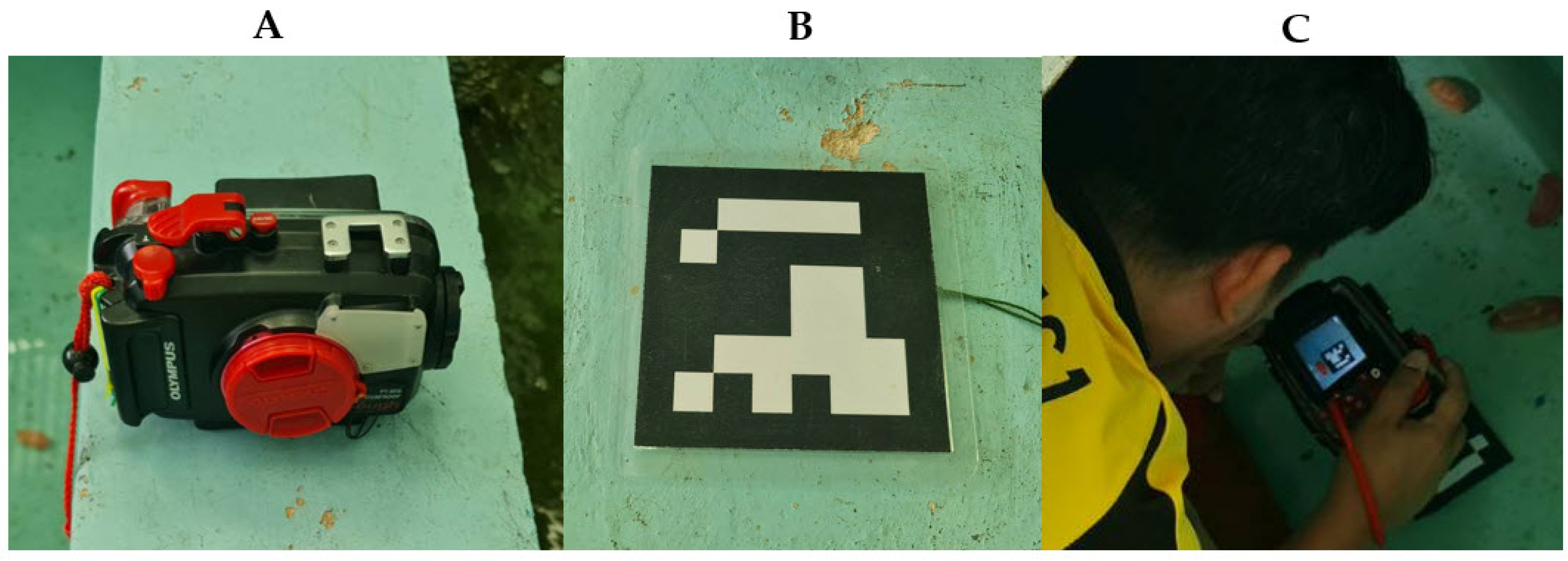


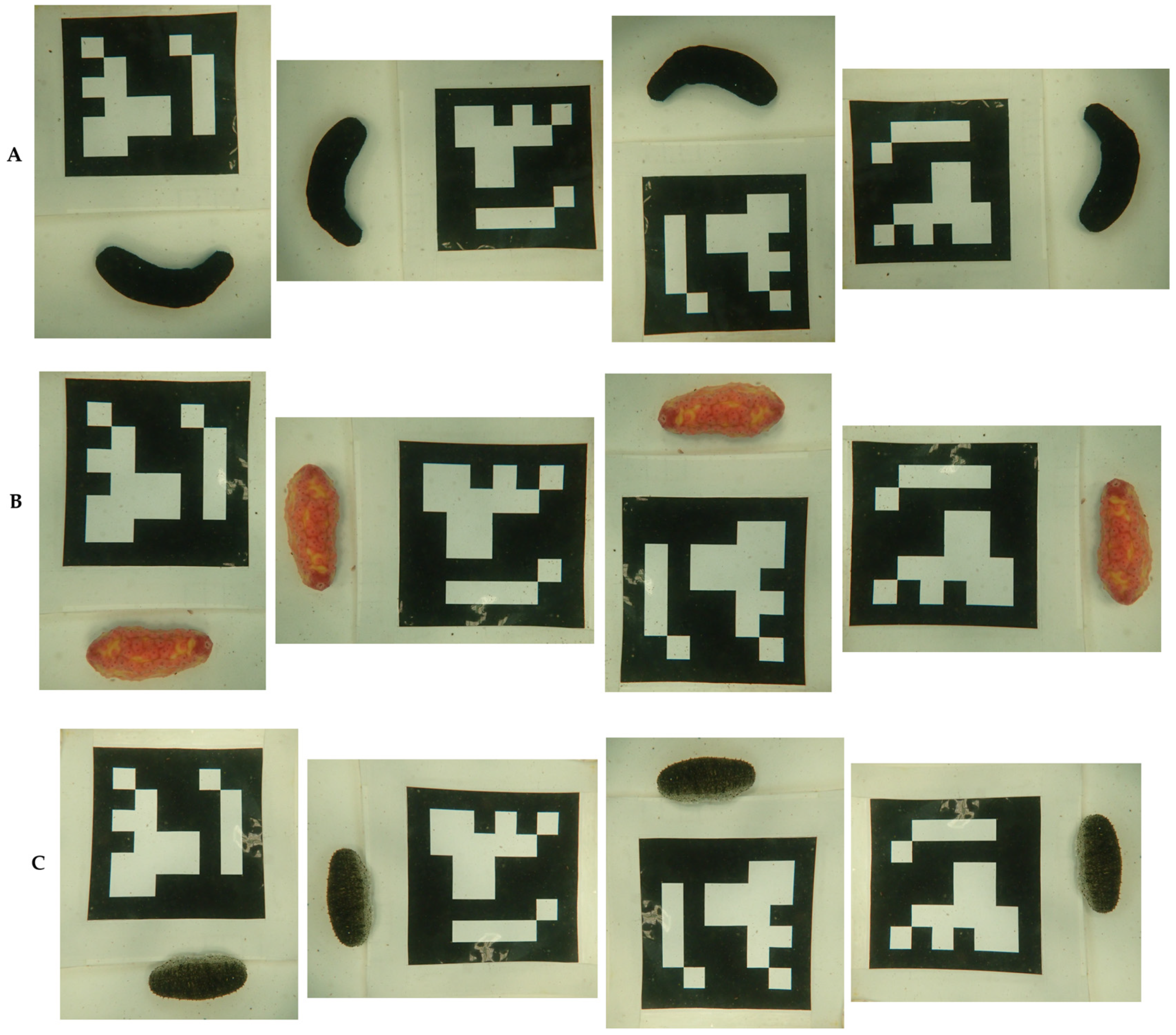

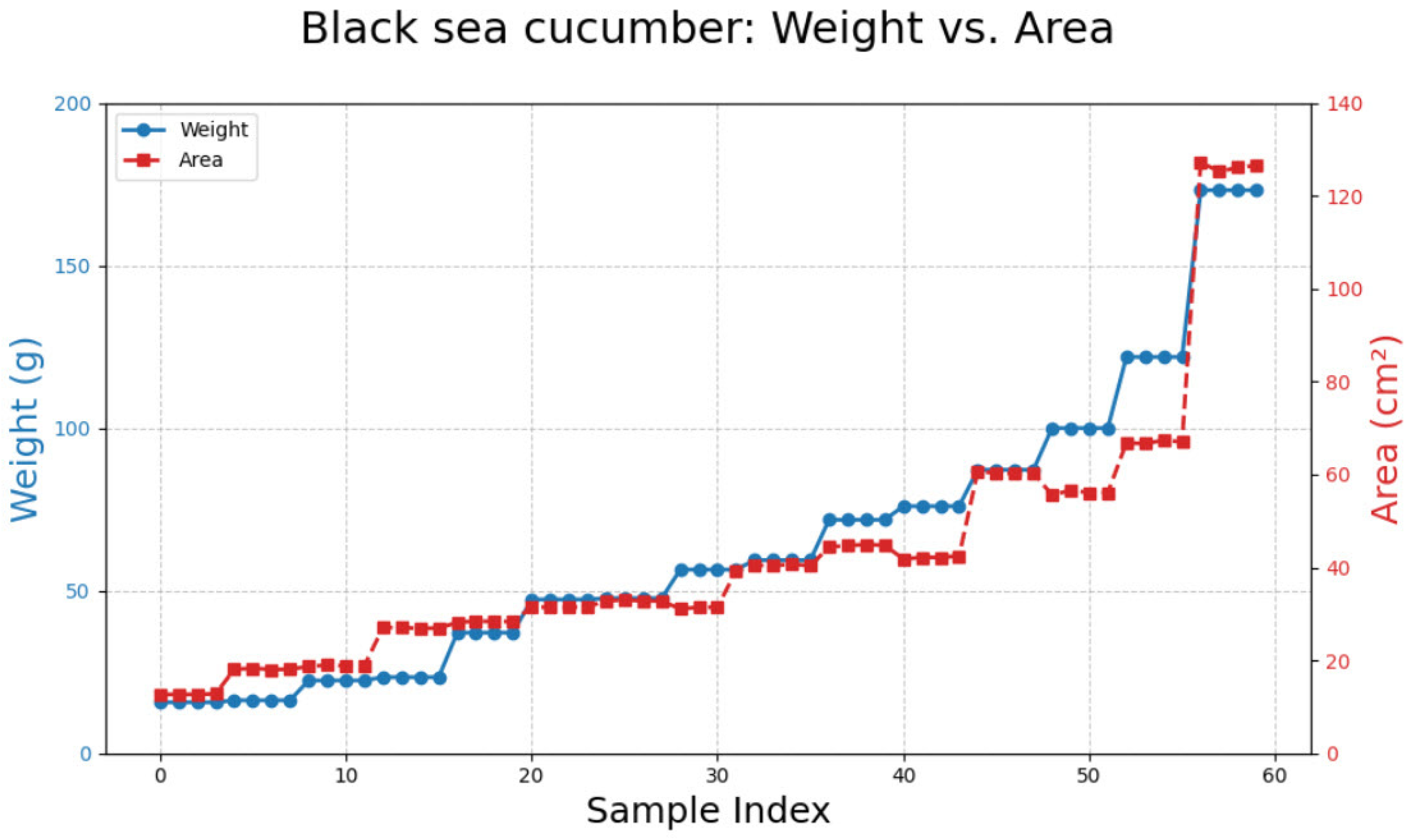
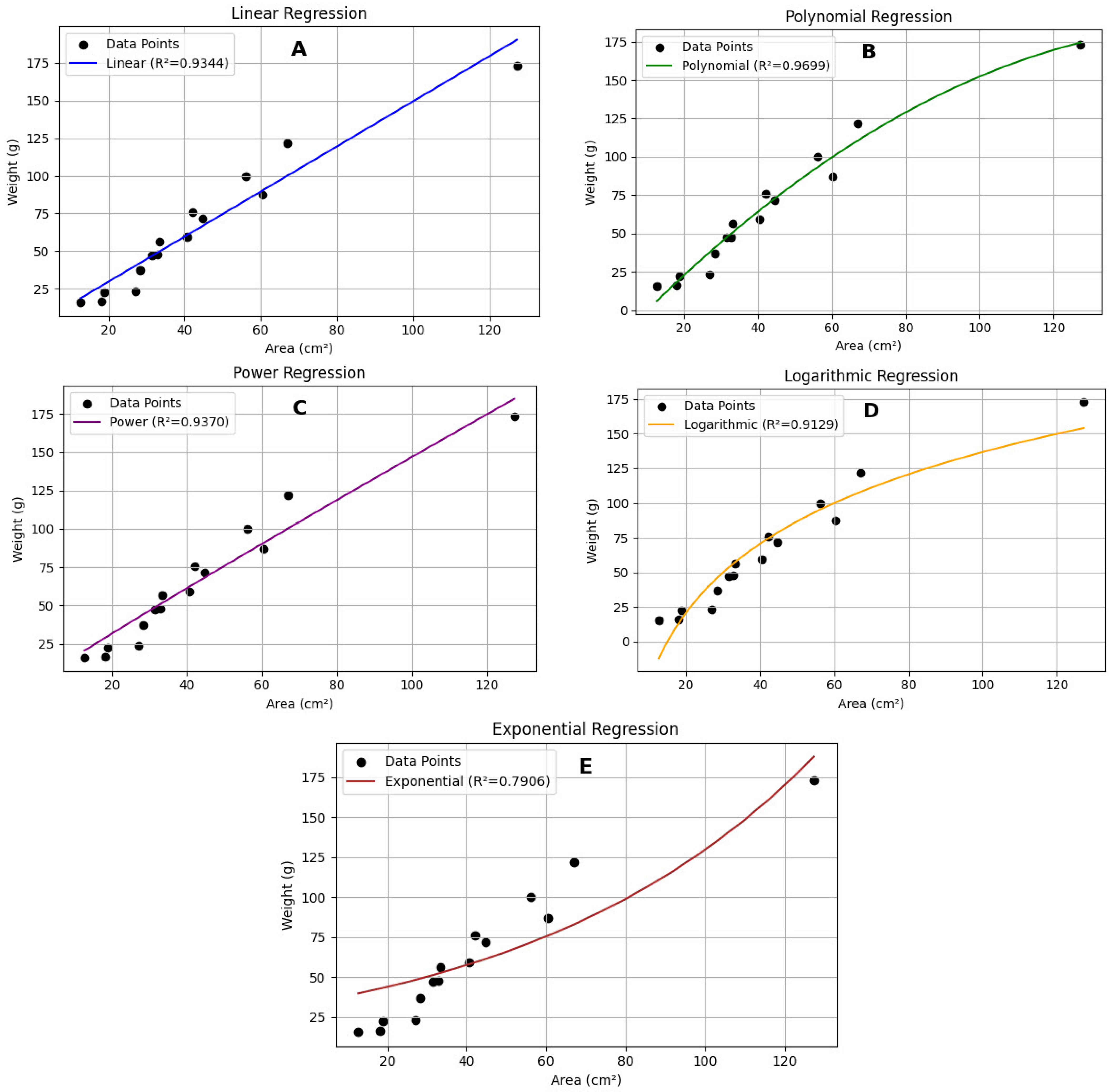
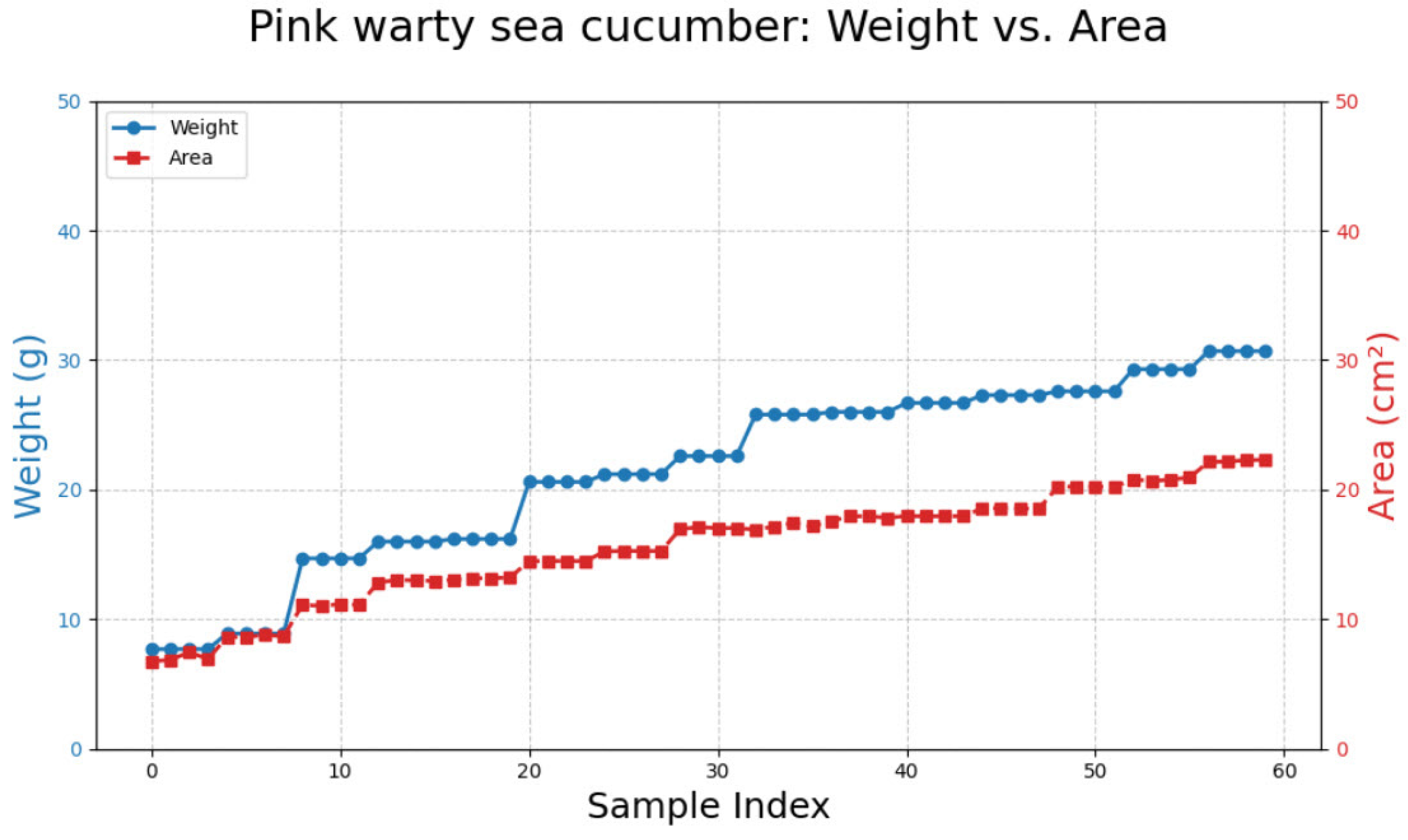

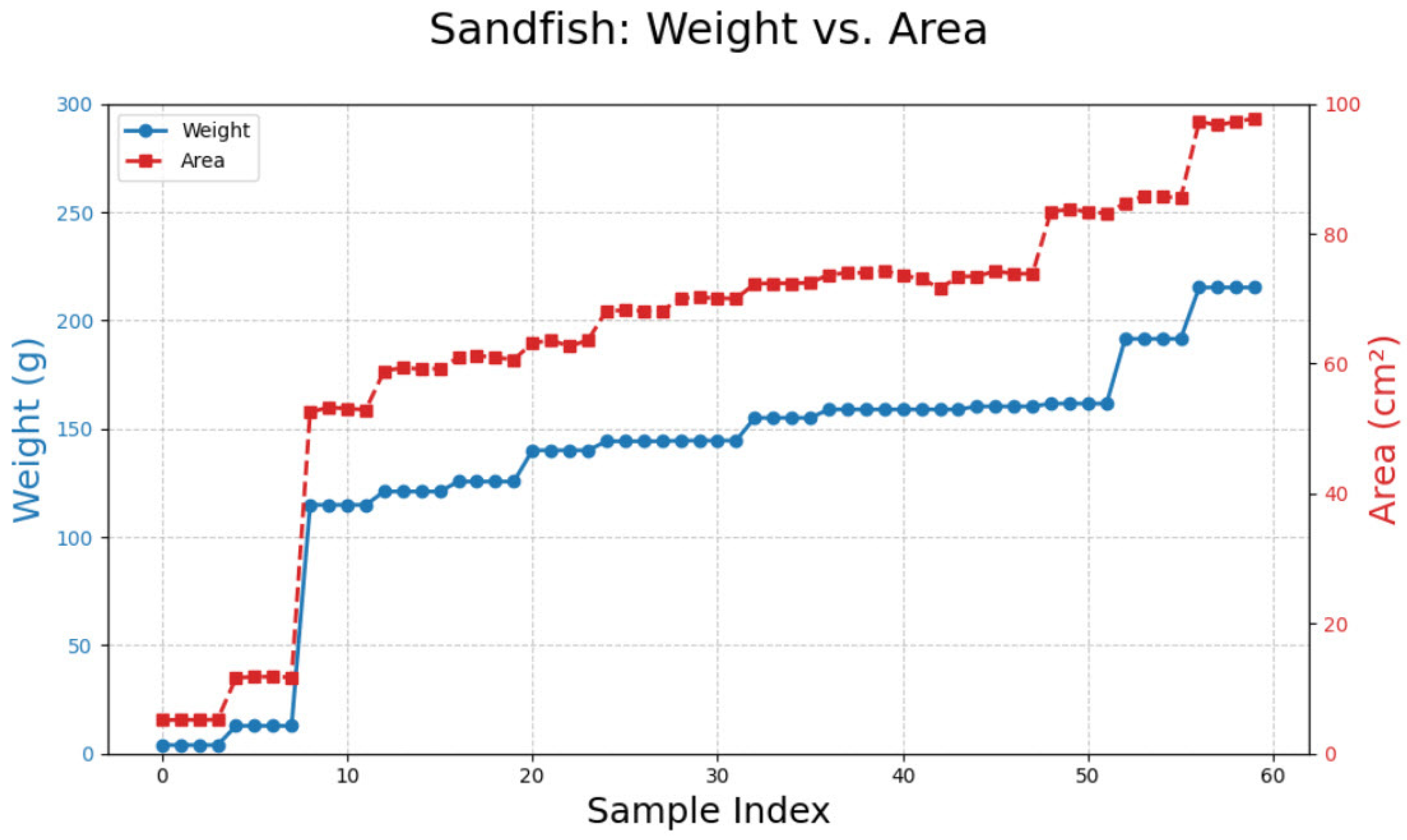


| Process | Details |
|---|---|
| 1. Install packages | Install rembg for background removal and onnxruntime for inference |
| 2. Mount Google Drive | Access images from Google Drive |
| 3. Import libraries | Load rembg, PIL, cv2, and numpy for processing |
| 4. Set image paths | Define input and output paths |
| 5. Open image | Read the image into memory |
| 6. Remove background | Use rembg to remove the background |
| 7. Apply transparency and white background | Convert to RGBA and place on a white background |
| 8. Convert to RGB and save | Remove transparency and save the final image |
| 9. Convert for OpenCV | Change to BGR format for processing |
| 10. ArUco marker detection | Detect markers after grayscale conversion |
| 11. Thresholding and contours | Apply Otsu’s thresholding and detect object contours |
| 12. Filter and process contours | Set a minimum area (5 cm2), calculate object area, convert pixels to cm2 using ArUco markers, and analyze valid contours |
| 13. Draw and overlay information | Display contours, bounding boxes, and object details |
| 14. Show final image | Present the processed image with annotations |
| Model | Equation | R2 |
|---|---|---|
| Linear | y = 1.4993x − 0.3209 | 0.9344 |
| Polynomial | y = −0.0075x2 + 2.5255x − 24.8202 | 0.9699 |
| Power | y = 1.8313x0.9522 | 0.9370 |
| Logarithmic | y = −195.3286 + 72.1146 In(x) | 0.9129 |
| Exponential | y = 33.5828 × 100.0135x | 0.7906 |
| Model | Equation | R2 |
|---|---|---|
| Linear | y = 1.6247x − 3.9756 | 0.9741 |
| Polynomial | y = −0.0209x2 + 2.2369x − 8.0638 | 0.9774 |
| Power | y = 0.8102x1.1886 | 0.9698 |
| Logarithmic | y = −37.3202 + 21.7212 In(x) | 0.9602 |
| Exponential | y = 6.2870 × 100.0756x | 0.9232 |
| Model | Equation | R2 |
|---|---|---|
| Linear | y = 2.2761x − 10.3947 | 0.9882 |
| Polynomial | y = 0.0002x2 + 2.2602x − 10.1545 | 0.9882 |
| Power | y = 1.3355x1.1086 | 0.9866 |
| Logarithmic | y = −132.1002 + 67.0347 In(x) | 0.8979 |
| Exponential | y = 38.1773 × 100.0187x | 0.9064 |
Disclaimer/Publisher’s Note: The statements, opinions and data contained in all publications are solely those of the individual author(s) and contributor(s) and not of MDPI and/or the editor(s). MDPI and/or the editor(s) disclaim responsibility for any injury to people or property resulting from any ideas, methods, instructions or products referred to in the content. |
© 2025 by the authors. Licensee MDPI, Basel, Switzerland. This article is an open access article distributed under the terms and conditions of the Creative Commons Attribution (CC BY) license (https://creativecommons.org/licenses/by/4.0/).
Share and Cite
Jongjaraunsuk, R.; Rermdumri, S.; Khaodon, K.; Intarachart, A.; Taparhudee, W. Underwater Weight Estimation of Three Sea Cucumber Species in Culture Tanks Using Image Analysis and ArUco Markers. Animals 2025, 15, 1121. https://doi.org/10.3390/ani15081121
Jongjaraunsuk R, Rermdumri S, Khaodon K, Intarachart A, Taparhudee W. Underwater Weight Estimation of Three Sea Cucumber Species in Culture Tanks Using Image Analysis and ArUco Markers. Animals. 2025; 15(8):1121. https://doi.org/10.3390/ani15081121
Chicago/Turabian StyleJongjaraunsuk, Roongparit, Saroj Rermdumri, Kanokwan Khaodon, Alongot Intarachart, and Wara Taparhudee. 2025. "Underwater Weight Estimation of Three Sea Cucumber Species in Culture Tanks Using Image Analysis and ArUco Markers" Animals 15, no. 8: 1121. https://doi.org/10.3390/ani15081121
APA StyleJongjaraunsuk, R., Rermdumri, S., Khaodon, K., Intarachart, A., & Taparhudee, W. (2025). Underwater Weight Estimation of Three Sea Cucumber Species in Culture Tanks Using Image Analysis and ArUco Markers. Animals, 15(8), 1121. https://doi.org/10.3390/ani15081121






